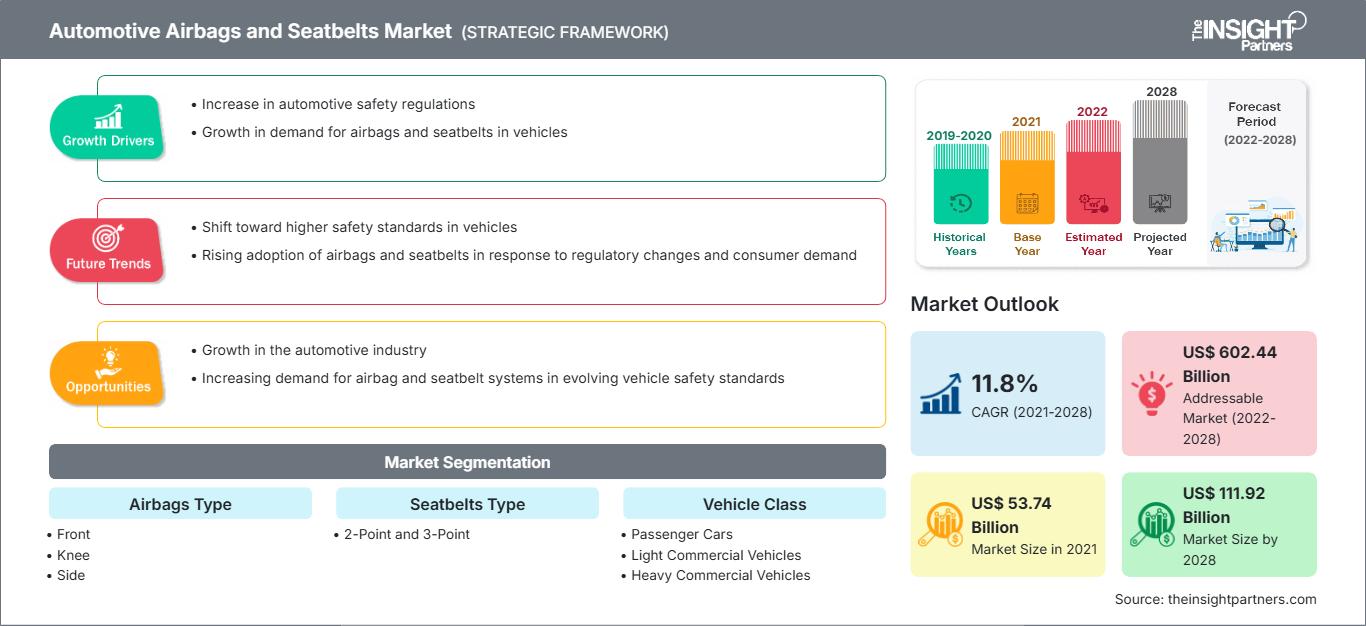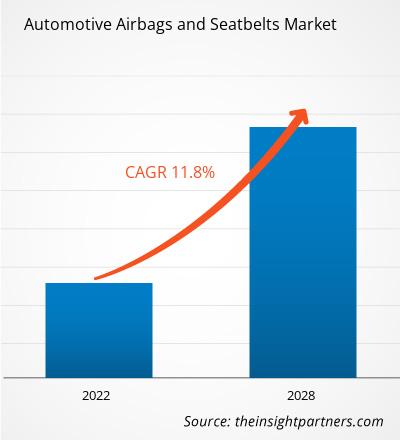Der Markt für Airbags und Sicherheitsgurte für Autos wurde im Jahr 2021 auf 53.744,00 Millionen US-Dollar geschätzt und soll bis 2028 111.917,12 Millionen US-Dollar erreichen; von 2022 bis 2028 wird eine durchschnittliche jährliche Wachstumsrate (CAGR) von 11,8 % erwartet.
Den Hauptakteuren auf dem Markt für Airbags und Sicherheitsgurte für Autos werden in den kommenden Jahren lukrative Möglichkeiten geboten, da zunehmend Initiativen zur Einführung von Regulierungsstandards im Bereich der Fahrzeugsicherheit ergriffen werden. Nach der COVID-19-Pandemie stiegen die Autoverkäufe stark an und die Zahl der Verkehrsunfälle nahm deutlich zu, und die Zahl der Unfälle nahm zu. Gleichzeitig wurde mit der rasanten Entwicklung von Wissenschaft und Technologie auch die Automobiltechnologie schnell verbessert, und die Fahrzeugsicherheitstechnologie hat nach und nach Einzug in alle Aspekte des Autos gehalten. Laut dem von der National Highway Traffic Safety Administration (NHTSA) veröffentlichten Bericht ist die Zahl der Verkehrstoten im Jahr 2021 um etwa 10,5 % höher als die im Jahr 2020 gemeldeten Todesfälle. Die geschätzte Zahl der Todesopfer ist die höchste seit 2005 und stellt den stärksten jährlichen prozentualen Anstieg in der Geschichte des Fatality Analysis Reporting System der USA dar. Daher legten die Regierungsbehörden großen Wert auf die Verbesserung von Sicherheitsrichtlinien und -standards sowie auf erhebliche Investitionen in die Reduzierung von Verkehrsunfällen. So bewilligte die NHTSA im Mai 2022 beispielsweise 740 Millionen US-Dollar an Fördermitteln für das 402 State and Community Grant Program, Section 1906 Racial Profiling Data Collection Grants und Section 405 National Priority Safety Program. Die Europäische Kommission arbeitet an der Ausarbeitung von Regulierungsstandards für Kraftfahrzeuge, die die Sicherheit der Fahrzeuginsassen und ungeschützter Verkehrsteilnehmer berücksichtigen. Die Europäische Kommission plant, aktualisierte UNECE-Vorschriften zu Sicherheitsgurten zu verabschieden, die ab September 2019 Sicherheitsgurt-Warnsysteme auf allen Vorder- und Rücksitzen in Neuwagen vorschreiben. Solche Initiativen zur Einführung von Regulierungsstandards in Bezug auf die Fahrzeugsicherheit kurbeln somit das Marktwachstum für Airbags und Sicherheitsgurte in Autos an.
Die zunehmende Verbreitung von Elektrofahrzeugen ist der zukünftige Trend auf dem Markt für Airbags und Sicherheitsgurte in Autos. Laut dem Global Electric Vehicle Outlook stiegen die Verkäufe von Elektroautos, einschließlich vollelektrischer und Plug-in-Hybridfahrzeuge, im Jahr 2021 auf einen neuen Rekordwert von 6,6 Millionen Einheiten. Dem gleichen Bericht zufolge stiegen die Verkäufe von Elektroautos in China im Jahr 2021 deutlich auf 3,3 Millionen und machten damit etwa die Hälfte der gesamten weltweiten Verkäufe aus. Auch in Europa stiegen die Elektrofahrzeugverkäufe stark um 65 % auf 2,3 Millionen Einheiten, und in den USA verdoppelten sich die Verkäufe 2021 auf 630.000 Einheiten. Fördernde staatliche Vorschriften für Ladestationen für Elektrofahrzeuge kurbeln den Absatz von Elektrofahrzeugen zusätzlich an und beflügeln damit die Nachfrage nach Airbags und Sicherheitsgurten für Autos. So schlug die US-Regierung im Juni 2022 neue Standards für ihr Programm zum Aufbau eines nationalen Netzwerks von 500.000 Ladestationen für Elektrofahrzeuge bis 2030 vor. Darüber hinaus hatte die Regierung einen Plan vorgestellt, den Bundesstaaten bis 2028 5 Milliarden US-Dollar zur Finanzierung von Ladestationen für Elektrofahrzeuge zuzuweisen. Daher wird erwartet, dass diese Wachstumsaussichten in der Elektrofahrzeugbranche den Markt für Airbags und Sicherheitsgurte für Autos im Prognosezeitraum ankurbeln werden.
Passen Sie diesen Bericht Ihren Anforderungen an
Sie erhalten kostenlos Anpassungen an jedem Bericht, einschließlich Teilen dieses Berichts oder einer Analyse auf Länderebene, eines Excel-Datenpakets sowie tolle Angebote und Rabatte für Start-ups und Universitäten.
Markt für Airbags und Sicherheitsgurte im Automobilbereich: Strategische Einblicke

- Holen Sie sich die wichtigsten Markttrends aus diesem Bericht.Dieses KOSTENLOSE Beispiel umfasst Datenanalysen, die von Markttrends bis hin zu Schätzungen und Prognosen reichen.
Sie erhalten kostenlos Anpassungen an jedem Bericht, einschließlich Teilen dieses Berichts oder einer Analyse auf Länderebene, eines Excel-Datenpakets sowie tolle Angebote und Rabatte für Start-ups und Universitäten.
Markt für Airbags und Sicherheitsgurte im Automobilbereich: Strategische Einblicke

- Holen Sie sich die wichtigsten Markttrends aus diesem Bericht.Dieses KOSTENLOSE Beispiel umfasst Datenanalysen, die von Markttrends bis hin zu Schätzungen und Prognosen reichen.
Auswirkungen der COVID-19-Pandemie auf den Markt für Airbags und Sicherheitsgurte in Kraftfahrzeugen
Der Ausbruch von COVID-19 hatte in den ersten Tagen seines Höhepunkts im Jahr 2020 dramatische Auswirkungen auf die Weltwirtschaft, und die Krise behinderte die Geschäftsaktivitäten in der Fertigungsindustrie. Vor dem Ausbruch von COVID-19 gab es erhebliche Investitionsinitiativen in die Entwicklung von Elektrofahrzeugen, um die Nachfrage nach Airbags und Sicherheitsgurten in Kraftfahrzeugen zu steigern. In den ersten Tagen der COVID-19-Pandemie schränkte die Krise alle Geschäftsabschlüsse, Kooperationen und Partnerschaften, die den Markt für Airbags und Sicherheitsgurte in Kraftfahrzeugen störten, erheblich ein. Das Auftreten der Pandemie behinderte den Fahrzeugabsatz im Februar 2020; darüber hinaus gingen die Verkäufe bis April in den USA um 47 % und in Europa um 80 % zurück. Laut einem Bericht von Statista sanken die weltweiten Autoverkäufe im Jahr 2020 auf 63,8 Millionen und erholten sich 2021 langsam mit 66 Millionen Verkäufen. Ab 2021 wurden die Marktteilnehmer mit verbindlichen Vorschriften zum Auslösen einer bestimmten Anzahl von Airbags konfrontiert, was Kosten verursacht. Dies zwang die Autohersteller, ihre Autos während der Erholungsphase von der Pandemie mit zusätzlichen Funktionen wie Airbags und Sicherheitsgurten zum gleichen Preis auszustatten. Die COVID-19-Pandemie traf die global integrierte Automobilindustrie rasch und schwerwiegend. Die Pandemie unterbrach die chinesischen Teileexporte, führte zu großflächigen Produktionsunterbrechungen in ganz Europa und zur Schließung von Montagewerken in den USA. Alle diese Faktoren führen zu einem Rückgang der weltweiten Nachfrage der Automobilindustrie nach Kraftfahrzeugen. Die COVID-19-Pandemie zwang Unternehmen dazu, ihre Geschäftsmodelle umzustrukturieren und Strategien zur Erzielung von Skaleneffekten zu stärken. Obwohl der globale Markt für Airbags und Sicherheitsgurte im Jahr 2020 aufgrund der negativen Auswirkungen der COVID-19-Pandemie und der damit verbundenen Vorschriften zunächst einbrach, erholte er sich nach der COVID-19-Pandemie stark.
Markteinblicke für Airbags und Sicherheitsgurte in der Automobilindustrie
Zunehmende Initiativen zur Einführung regulatorischer Standards im Zusammenhang mit der Fahrzeugsicherheit
Die Automobilindustrie ist eine Säule der Weltwirtschaft. Sie spielt eine entscheidende Rolle für die Volkswirtschaft eines Landes und trägt über viele angrenzende Sektoren hinweg zum makroökonomischen Wachstum und zur Stabilität in Industrie- und Entwicklungsländern bei. Nach der COVID-19-Pandemie stiegen die Autoverkäufe stark an und die Zahl der Verkehrsunfälle wurde immer häufiger und schwerer. Gleichzeitig wurde mit der rasanten Entwicklung von Wissenschaft und Technologie auch die Automobiltechnologie schnell verbessert, und die Fahrzeugsicherheitstechnologie hat nach und nach Einzug in alle Aspekte des Autos gehalten. Laut dem von der National Highway Traffic Safety Administration (NHTSA) veröffentlichten Bericht ist die Zahl der Verkehrstoten im Jahr 2021 im Vergleich zu den im Jahr 2020 gemeldeten Todesfällen um etwa 10,5 % gestiegen. Die geschätzte Zahl der Todesopfer ist die höchste seit 2005 und der größte jährliche prozentuale Anstieg in der Geschichte des Fatality Analysis Reporting System der USA. Daher legten die Regierungsbehörden großen Wert auf die Verbesserung von Sicherheitsrichtlinien und -standards sowie auf erhebliche Investitionen in die Reduzierung von Verkehrsunfällen. So genehmigte die NHTSA im Mai 2022 Fördermittel in Höhe von 740 Millionen US-Dollar für das 402 State and Community Grant Program, Section 1906 Racial Profiling Data Collection Grants und Section 405 National Priority Safety Program. Daher treiben Initiativen zur Einführung regulatorischer Standards in Bezug auf die Fahrzeugsicherheit das Wachstum des Marktes für Airbags und Sicherheitsgurte in Autos voran.
Markteinblicke nach Airbagtypen
Basierend auf dem Airbagtyp ist der Markt für Airbags und Sicherheitsgurte in Autos in Front-, Knie-, Seiten- und Vorhangairbags unterteilt. Frontairbagsysteme werden zunehmend zur Sicherheit des Fahrers eingesetzt und sind aufgrund der weltweiten Regulierungsbehörden verpflichtend. Darüber hinaus geben Verbraucher aufgrund des wachsenden Bewusstseins für Fahrzeugsicherheit und des steigenden verfügbaren Einkommens mehr Geld für die Sicherheitsausstattung ihrer Fahrzeuge aus. Top-Hersteller statten ihre Fahrzeuge jetzt mit Seitenairbags (SABs) aus, um schwere Brustverletzungen bei Seitenaufprallen zu verringern. Ein neuer Front-Center-Airbag von Autoliv Inc. wurde 2019 eingeführt. Es befindet sich im Bereich zwischen Fahrer und Beifahrer und verringert das Risiko von Brust-, Schulter- und Kopfverletzungen und rettet bei Seitenaufprallen Leben.
Airbags und Sicherheitsgurte im AutoRegionale Einblicke in den Markt für Airbags und Sicherheitsgurte im Automobilbereich
Regionale Einblicke in den Markt für Airbags und Sicherheitsgurte im Automobilbereich
Die Analysten von The Insight Partners haben die regionalen Trends und Faktoren, die den Markt für Airbags und Sicherheitsgurte im Automobilbereich im Prognosezeitraum beeinflussen, ausführlich erläutert. In diesem Abschnitt werden auch die Marktsegmente und die geografische Lage in Nordamerika, Europa, im asiatisch-pazifischen Raum, im Nahen Osten und Afrika sowie in Süd- und Mittelamerika erörtert.
Umfang des Marktberichts zu Airbags und Sicherheitsgurten für Kraftfahrzeuge
| Berichtsattribut | Einzelheiten |
|---|---|
| Marktgröße in 2021 | US$ 53.74 Billion |
| Marktgröße nach 2028 | US$ 111.92 Billion |
| Globale CAGR (2021 - 2028) | 11.8% |
| Historische Daten | 2019-2020 |
| Prognosezeitraum | 2022-2028 |
| Abgedeckte Segmente |
By Airbag-Typ
|
| Abgedeckte Regionen und Länder | Nordamerika
|
| Marktführer und wichtige Unternehmensprofile |
|
Dichte der Marktteilnehmer für Airbags und Sicherheitsgurte im Automobilbereich: Verständnis ihrer Auswirkungen auf die Geschäftsdynamik
Der Markt für Airbags und Sicherheitsgurte für Autos wächst rasant. Die steigende Nachfrage der Endverbraucher ist auf Faktoren wie veränderte Verbraucherpräferenzen, technologische Fortschritte und ein stärkeres Bewusstsein für die Produktvorteile zurückzuführen. Mit der steigenden Nachfrage erweitern Unternehmen ihr Angebot, entwickeln Innovationen, um den Bedürfnissen der Verbraucher gerecht zu werden, und nutzen neue Trends, was das Marktwachstum weiter ankurbelt.

- Holen Sie sich die Markt für Airbags und Sicherheitsgurte im Automobilbereich Übersicht der wichtigsten Akteure
Markteinblicke nach Sicherheitsgurttypen
Basierend auf dem
Sicherheitsgurttyp
wird der Markt für Autoairbags und -sicherheitsgurte in 2-Punkt- und 3-Punkt-Sicherheitsgurte unterteilt. Aufgrund seiner vorteilhaften Eigenschaften wird erwartet, dass das 3-Punkt-Segment einen größeren Marktanteil bei Autoairbags und -sicherheitsgurten einnehmen wird. Die indische Regierung wird Autohersteller bald dazu verpflichten, alle Sitze, einschließlich des mittleren hinten, mit Dreipunktgurten auszustatten. Beckengurte gelten als weniger sicher als Dreipunktgurte. Im Falle eines Unfalls soll die neue Regelung die Sicherheit der Passagiere allgemein erhöhen. Das Ministerium für Straßenverkehr und Autobahnen hat einen Entwurf einer Benachrichtigung genehmigt, der Automobilhersteller dazu verpflichtet, mindestens sechs Airbags in Fahrzeugen mit bis zu acht Sitzplätzen vorzusehen.Die Akteure auf dem Markt für Airbags und Sicherheitsgurte für Autos verfolgen Strategien wie Fusionen, Übernahmen und Marktinitiativen, um ihre Position auf dem Markt zu behaupten. Im Folgenden sind einige Entwicklungen der wichtigsten Akteure auf dem Markt für Airbags und Sicherheitsgurte für Autos aufgeführt:
- Im Februar 2022 gab Autoliv, Inc. seine Zusammenarbeit mit Nuro bekannt, einem Unternehmen für autonome Fahrzeuge, um Nuros neuestes Fahrzeug der dritten Generation mit Außenairbags mit besseren Sicherheitsfunktionen auszustatten.
- Im April 2021 entwickelte die Continental AG neue Funktionen für ihre Airbag-Steuergeräte. Das Unternehmen wollte Signale von Steuergeräten nutzen und Funktionen für eine schnellere Auslösung der Airbags entwickeln, insbesondere bei einem Seitenaufprall.
Der globale Markt für Airbags und Sicherheitsgurte für Autos ist nach Airbagtyp, Sicherheitsgurttyp und Fahrzeugklasse segmentiert. Der Markt für Autoairbags und -sicherheitsgurte ist je nach Airbagtyp in Front-, Knie-, Seiten- und Vorhangairbags unterteilt. Hinsichtlich Sicherheitsgurttyp ist der Markt in 2-Punkt- und 3-Punkt-Airbags unterteilt. Darüber hinaus ist der Markt für Autoairbags und -sicherheitsgurte je nach Fahrzeugklasse in Pkw, leichte Nutzfahrzeuge und schwere Nutzfahrzeuge unterteilt.
Autoliv, ZF Friedrichshafen AG, TOYODA GOSEI Co., Ltd., Joyson Safety Systems und Continental AG sind die wichtigsten Marktteilnehmer für Autoairbags und -sicherheitsgurte, die für diese Studie berücksichtigt wurden. Darüber hinaus wurden in diesem Forschungsbericht mehrere weitere bedeutende Marktteilnehmer für Autoairbags und -sicherheitsgurte untersucht und analysiert, um einen ganzheitlichen Überblick über den globalen Markt für Autoairbags und -sicherheitsgurte und sein Ökosystem zu erhalten.
- Historische Analyse (2 Jahre), Basisjahr, Prognose (7 Jahre) mit CAGR
- PEST- und SWOT-Analyse
- Marktgröße Wert/Volumen – Global, Regional, Land
- Branchen- und Wettbewerbslandschaft
- Excel-Datensatz
Aktuelle Berichte
Verwandte Berichte
Erfahrungsberichte
Grund zum Kauf
- Fundierte Entscheidungsfindung
- Marktdynamik verstehen
- Wettbewerbsanalyse
- Kundeneinblicke
- Marktprognosen
- Risikominimierung
- Strategische Planung
- Investitionsbegründung
- Identifizierung neuer Märkte
- Verbesserung von Marketingstrategien
- Steigerung der Betriebseffizienz
- Anpassung an regulatorische Trends




















 Kostenlose Probe anfordern für - Markt für Airbags und Sicherheitsgurte im Automobilbereich
Kostenlose Probe anfordern für - Markt für Airbags und Sicherheitsgurte im Automobilbereich